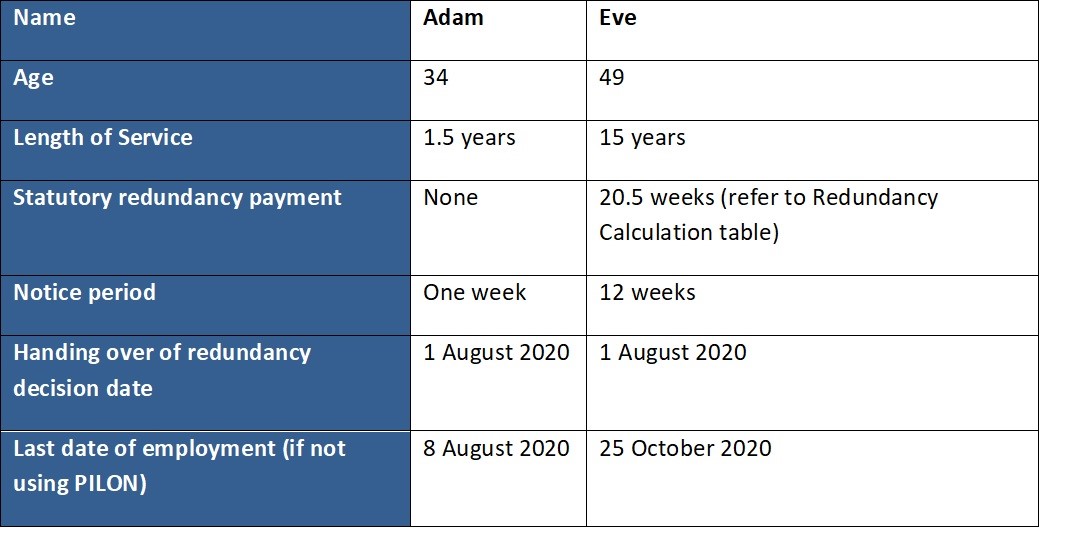How to Handle Redundancy Pay If Company Goes Bust: Secret Information for UK Workers
How to Handle Redundancy Pay If Company Goes Bust: Secret Information for UK Workers
Blog Article
Exploring the Interaction Between Business Redundancy and Business Flexibility for Future Growth
In the dynamic landscape of today's organization world, the complex partnership between company redundancy and business versatility arises as a crucial factor for continual development and success. Business usually deal with the challenge of striking a delicate balance between maintaining a level of redundancy to alleviate threats and promoting versatility to react promptly to the ever-evolving market demands.
Relevance of Firm Redundancy
Company redundancy is a crucial aspect that enhances business strength and mitigates operational dangers. By including redundancy procedures within the organizational framework, firms can much better endure unexpected interruptions and fluctuations in the organization environment. Redundancy works as a strategic buffer, enabling companies to adjust and respond effectively to unexpected obstacles without endangering crucial operations.
One trick facet of the relevance of company redundancy is its duty in guaranteeing continuity throughout times of situation. When faced with unexpected modifications or emergency situations, repetitive systems, resources, or workers can step in to preserve critical features and prevent widespread disruptions. This connection not just safeguards the company's track record and consumer count on but likewise reduces monetary losses and functional downtime.

Approaches for Organizational Versatility

An additional crucial technique is buying modern technology and framework that can support adaptability and scalability. Executing digital tools, automation, and data analytics can improve procedures, improve effectiveness, and provide beneficial insights for notified decision-making. In addition, developing adaptable business structures that allow for fast modifications to market dynamics and consumer requirements is important for remaining affordable in a swiftly developing setting. By proactively identifying possible disturbances and opportunities, organizations can proactively adapt and grow in an ever-changing company landscape.
Harmonizing Redundancy and Adaptability
Achieving a harmonious balance between operational redundancy and business versatility is critical in browsing the intricacies of a dynamic company atmosphere. Redundancy within a firm provides a safety and security internet, ensuring continuity and security in procedures. Nonetheless, an excess of redundancy can lead to inefficiencies and hinder flexibility to changing market problems. On the other hand, business adaptability permits companies to respond without delay to external interruptions and take new possibilities. Striking the best equilibrium between redundancy and adaptability is a delicate procedure that requires a deep understanding of the company's objectives, industry dynamics, and risk resistance.
To attain this balance, business need to carry out regular assessments of their operations to recognize locations where redundancy is necessary for danger reduction and where adaptability can drive development and growth. Applying flexible frameworks, cultivating a culture of continuous understanding and improvement, and urging open interaction throughout all levels of the organization are essential strategies to integrate redundancy and flexibility properly. By straightening these two vital elements, firms can place themselves for lasting growth and success in an ever-changing business landscape.
Study on Adaptation Success
In examining circumstances of effective organizational adaptation, it becomes apparent that the interplay in between operational redundancy and flexibility is a defining consider forming durable organizations. One engaging study is that of Netflix. At first a DVD rental solution, Netflix demonstrated remarkable versatility by transitioning into a streaming platform when digitalization disrupted the industry. By strategically investing in modern technology and content development, Netflix not just endured yet grew in a rapidly evolving market. Another standout instance is Amazon. Beginning as an online book shop, Amazon continuously adapted its business design, broadening into varied sectors such as cloud computing and expert system. This versatility enabled Amazon to stay ahead of rivals and fulfill transforming customer demands. Lastly, Adobe supplies a significant image of effective adjustment. The firm moved from marketing software application licenses to a subscription-based model, making certain reoccuring earnings streams and enhanced customer interaction. These situation research studies underscore the significance of functional redundancy combined with organizational flexibility in promoting long-lasting growth and competition.
Building Durability for Future Development
Structure strength for future development needs a critical positioning of operational processes with market dynamics and arising fads. Companies have to adjust to changing atmospheres by cultivating a culture of versatility, technology, and constant enhancement. Resilience entails not only recovering from setbacks yet also proactively getting ready for future challenges. One key aspect of building durability is buying robust danger administration strategies to reduce prospective interruptions. This consists of situation preparation, branching out supply chains, and creating backup plans for various contingencies (who pays redundancy money).
Moreover, promoting strong relationships with stakeholders, such as clients, staff members, suppliers, and the area, is important for weathering uncertainties and maintaining depend on and support throughout turbulent times. Reliable interaction and openness play an important function in building resilience, as they help facilitate and line up expectations cooperation in navigating uncertainties.
In addition, organizations require to prioritize understanding and advancement initiatives to upskill employees and equip them with the needed tools i was reading this to adapt to transforming circumstances. By investing in their labor force, business can boost their versatility and dexterity, inevitably reinforcing their resilience for lasting future development.
Final Thought

In the dynamic landscape of today's company globe, the elaborate relationship between firm redundancy and organizational flexibility emerges as a critical aspect for continual growth and success. Companies typically encounter the challenge of striking a delicate equilibrium in between keeping a level of redundancy to alleviate threats and promoting versatility to react promptly to the ever-evolving market needs.To achieve this equilibrium, companies need to carry out normal assessments of their operations to recognize areas where redundancy is necessary for danger reduction and where flexibility can drive advancement more and growth.In conclusion, the interaction between business redundancy and organizational adaptability is important for future development. Building resilience through a mix of redundancy and flexibility will certainly guarantee that companies are prepared for the challenges of the future.
Report this page